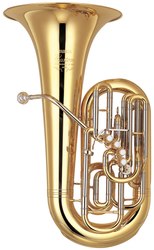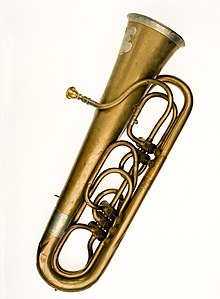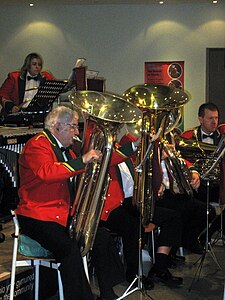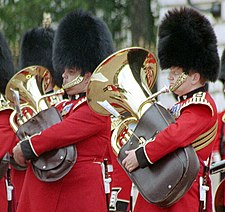How To Work On Low Register Tuba
 A bass tuba in F | |
| Brass instrument | |
|---|---|
| Nomenclature |
|
| Hornbostel–Sachs nomenclature | 423.232 (Valved aerophone sounded by lip vibration) |
| Inventor(due south) | Wilhelm Friedrich Wieprecht and Johann Gottfried Moritz |
| Developed | 1835 |
| Playing range | |
| | |
| Related instruments | |
| |
The tuba (;[1] ) is the lowest-pitched musical instrument in the contumely family unit. Every bit with all contumely instruments, the audio is produced by lip vibration – a buzz – into a mouthpiece. Information technology beginning appeared in the mid-19th century, making information technology ane of the newer instruments in the modern orchestra and concert ring. The tuba largely replaced the ophicleide.[2] Tuba is Latin for "trumpet".[iii]
A person who plays the tuba is called a tubaist, a tubist,[four] or simply a tuba actor. In a British brass band or military band, they are known as bass players.
History [edit]

Tuba by Wieprecht & Moritz as described in Prussian patent No.xix.
Prussian Patent No. 19 was granted to Wilhelm Friedrich Wieprecht and Johann Gottfried Moritz (1777–1840)[5] on September 12, 1835 for a "bass tuba" in F1. The original Wieprecht and Moritz musical instrument used five valves of the Berlinerpumpen blazon that were the forerunners of the modern piston valve. The first tenor tuba was invented in 1838 by Carl Wilhelm Moritz (1810–1855), son of Johann Gottfried Moritz.
The addition of valves fabricated information technology possible to play low in the harmonic series of the musical instrument and still have a complete selection of notes. Prior to the invention of valves, brass instruments were limited to notes in the harmonic series, and were thus generally played very high with respect to their fundamental pitch. Harmonics starting three octaves above the primal pitch are about a whole pace apart, making a useful variety of notes possible.
The ophicleide used a bowl-shaped brass instrument mouthpiece but employed keys and tone holes similar to those of a mod saxophone. Another forerunner to the tuba was the serpent, a bass instrument that was shaped in a wavy form to make the tone holes attainable to the actor. Tone holes changed the pitch by providing an intentional leak in the bugle of the instrument. While this changed the pitch, it likewise had a pronounced event on the timbre. By using valves to accommodate the length of the bugle the tuba produced a smoother tone that eventually led to its popularity. These popular instruments were more often than not written for by French composers, especially Hector Berlioz. Berlioz famously wrote for the ophicleide in his compositions Symphonie fantastique and Benvenuto Cellini (opera). These pieces are at present ordinarily performed on F or CC tuba.
Adolphe Sax, similar Wieprecht, was interested in marketing systems of instruments from soprano to bass, and developed a serial of brass instruments known as saxhorns. The instruments developed by Sax were generally pitched in E ♭ and B ♭ , while the Wieprecht "basstuba" and the subsequent Cerveny contrabass tuba were pitched in F and C (see below on pitch systems). Sax'south instruments gained dominance in France, and later in Britain and America, as a result of the popularity and movements of musical instrument makers such as Gustave Auguste Besson (who moved from France to Great britain) and Henry Distin (who eventually constitute his style to America).[half-dozen]
The cimbasso is also seen instead of a tuba in the orchestral repertoire. The proper noun is translated from "corno in basso" in German. The original design was inspired by the ophicleide and bassoon.[seven] The cimbasso is rare today, but it is sometimes used in historically accurate performances.
Part [edit]
An orchestra commonly has a single tuba, though an additional tuba may exist requested. It serves every bit the bass of the orchestral brass department and information technology can reinforce the bass voices of the strings and woodwinds. It provides the bass of brass quintets and choirs (though many small contumely ensembles will use the euphonium or bass trombone as the lowest voice). Information technology is the principal bass instrument in concert bands, brass bands and military bands, and those ensembles generally take two to four tubas. It is besides a solo musical instrument.
Tubas are used in marching bands, drum and bugle corps and in many jazz bands (see beneath). In British style brass bands, two E ♭ and two B ♭ tubas are used and are referred to as basses.
Well known and influential parts for the tuba include:
- Modest Mussorgsky (orch. Ravel): Pictures at an Exhibition – Bydło, Nighttime On Bald Mount
- Richard Strauss: As well sprach Zarathustra, Eine Alpensinfonie, Till Eulenspiegel, Ein Heldenleben
- Shostakovich: All Symphonies, except for the Fourteenth symphony
- Stravinsky: The Rite of Spring, Petroushka
- Edgard Varèse: Déserts
- Richard Wagner: Die Meistersinger von Nürnberg, Lohengrin, Ride of the Valkyries, Faust Overture
- Sergei Prokofiev: Fifth Symphony
- George Gershwin: An American in Paris
- Silvestre Revueltas: Sensemayá, La noche de los mayas, Homenaje a Federico García Lorca
- Gustav Holst: The Planets
- Gustav Mahler: First Symphony, Second Symphony, Fifth Symphony, 6th Symphony, Eighth Symphony
- Ottorino Respighi: Fountains of Rome, Pines of Rome
- Hector Berlioz: Symphonie fantastique, Hungarian March
- Paul Hindemith: Symphonic Metamorphosis
- Johannes Brahms: Second Symphony
- Anton Bruckner: Fourth Symphony, Seventh Symphony, 8th Symphony
Concertos accept been written for the tuba past many notable composers, including Ralph Vaughan Williams (Tuba Concerto), Edward Gregson, John Williams, Alexander Arutiunian, Eric Ewazen, James Barnes, Joseph Hallman, Martin Ellerby, Philip Sparke, Kalevi Aho, Josef Tal, Bruce Broughton (Tuba Concerto), John Golland, Roger Steptoe, David Carlson, Jennifer Higdon (Tuba Concerto) and Marcus Paus (Tuba Mirum).
Types and construction [edit]

Tubas are plant in various pitches, most commonly in F, Due east ♭ , C, or B ♭ . The primal of a tuba depends on the fundamental pitch of the instrument, or primal note in the series of overtones (also called partials) available without any valves being pressed. Tubas in dissimilar keys use different lengths of tubing. The main tube of a B ♭ tuba is approximately 18 feet (five.5 yard) long, while that of a C tuba is sixteen feet (4.9 m), of an E ♭ tuba 13 feet (iv.0 m), and of an F tuba 12 anxiety (iii.7 one thousand). The instrument has a conical bore, meaning the bore bore increases equally a part of the tubing length from the mouthpiece to the bong. The conical diameter causes the instrument to produce a preponderance of even-order harmonics.
A tuba with its tubing wrapped for placing the instrument on the actor's lap is usually called a concert tuba or simply a tuba. Tubas with the bell pointing forward (pavillon tournant) instead of upward are often called recording tubas because of their popularity in the early days of recorded music, as their sound could more hands be directed at the recording microphone. When wrapped to surround the trunk for cavalry bands on horseback or marching, it is traditionally known as a helicon. The modernistic sousaphone, named after American bandmaster John Philip Sousa, resembles a helicon with the bong pointed up (in the original models as the J. W. Pepper epitome and Sousa's concert instruments) and then curved to point frontwards (as adult by Conn and others). Some ancestors of the tuba, such as the military bombardon, had unusual valve and bore arrangements compared to modern tubas.
During the American Ceremonious War, almost brass bands used a branch of the brass family known as saxhorns, which, by today'due south standards, accept a narrower bore taper than tuba—the same every bit truthful cornets and baritones, only distinct from trumpets, euphoniums, and others with different tapers or no taper. Around the start of the Civil War, saxhorns manufactured for military utilize in the USA were commonly wrapped with the bell pointing backwards over the player's shoulder, and these were known as over-the-shoulder saxhorns, and came in sizes from cornets down to Eastward ♭ basses. However, the E ♭ bass, even though it shared the same tube length equally a modern E ♭ tuba, has a narrower bore and as such cannot be called by the name tuba except as a convenience when comparing it to other sizes of the Saxhorn.
Most music for the tuba is written in bass clef in concert pitch, so tuba players must know the correct fingerings for their specific instruments. Traditional British-style contumely ring parts for the tuba are ordinarily written in treble clef, with the B ♭ tuba sounding two octaves and i step below and the E ♭ tuba sounding i octave and a major sixth below the written pitch. This allows musicians to change instruments without learning new fingerings for the aforementioned written music. Consequently, when its music is written in treble clef, the tuba is a transposing instrument, just non when the music is in bass clef.
The everyman pitched tubas are the contrabass tubas, pitched in C or B ♭ , referred to as CC and BB ♭ tubas respectively, based on a traditional baloney of a now-obsolete octave naming convention. The fundamental pitch of a CC tuba is 32 Hz, and for a BB ♭ tuba, 29 Hz. The CC tuba is used as an orchestral, and concert band instrument in the U.South., merely BB ♭ tubas are the contrabass tuba of choice in German language, Austrian, and Russian orchestras. In the U.s.a., the BB ♭ tuba is the most common in schools (largely due to the apply of BB ♭ sousaphones in high school marching bands) and for developed amateurs. Many professionals in the U.S. play CC tubas, with BB ♭ also common, and many train in the apply of all four pitches of tubas.[ commendation needed ]

Comparison of euphonium (left) and tuba (right)
The adjacent smaller tubas are the bass tubas, pitched in F or E ♭ (a quaternary above the contrabass tubas). The E ♭ tuba oft plays an octave above the contrabass tubas in brass bands, and the F tuba is commonly used by professional players as a solo musical instrument and, in America, to play college parts in the classical repertoire (or parts that were originally written for the F tuba, as is the case with Berlioz). In most of Europe, the F tuba is the standard orchestral instrument, supplemented past the CC or BB ♭ just when the actress weight is desired. Wagner, for case, specifically notates the low tuba parts for Kontrabasstuba, which are played on CC or BB ♭ tubas in near regions. In the United Kingdom, the E ♭ is the standard orchestral tuba.
The euphonium is sometimes referred to as a tenor tuba and is pitched in B ♭ , i octave higher than the BB ♭ contrabass tuba. The term "tenor tuba" is oftentimes used more specifically to refer to B ♭ rotary-valved tubas pitched in the same octave equally euphoniums. The "Small Swiss Tuba in C" is a tenor tuba pitched in C, and provided with half-dozen valves to make the lower notes in the orchestral repertoire possible. The French C tuba was the standard musical instrument in French orchestras until overtaken by F and C tubas since the Second World War. One pop case of the employ of the French C tuba is the Bydło movement in Ravel's orchestration of Mussorgsky'southward Pictures at an Exhibition, though the residual of the work is scored for this musical instrument as well.
Larger BBB ♭ subcontrabass tubas be, merely are extremely rare (in that location are at least four known examples). The first two were congenital by Gustave Besson in BBB ♭ , one octave below the BB ♭ Contrabass tuba, on the proposition of John Philip Sousa. The monster instruments were non completed until just afterwards Sousa'due south decease. Later, in the 1950s, British musician Gerard Hoffnung commissioned the London firm of Paxman to create a subcontrabass tuba in EEE ♭ for use in his comedic music festivals. Besides, a tuba pitched in FFF was made in Kraslice by Bohland & Fuchs probably during 1910 or 1911 and was destined for the World Exhibition in New York in 1913. Two players are needed; 1 to operate the valves and one to accident into the mouthpiece.
Size vs. pitch [edit]
In improver to the length of the instrument, which dictates the fundamental pitch, tubas also vary in overall width of the tubing sections. Tuba sizes are normally denoted by a quarter system, with four⁄iv designating a normal, full-size tuba. Larger rotary instruments are known as kaisertubas and are oftentimes denoted 5⁄4 . Larger piston tubas, especially those with front action, are sometimes known as m orchestral tubas (examples: the Conn 36J Orchestra K Bass from the 1930s, and the current model Hirsbrunner HB-50 Thousand Orchestral, which is a replica of the big York tubas endemic by the Chicago Symphony Orchestra). Grand orchestral tubas are mostly described every bit 6⁄four tubas. Smaller instruments may be described every bit iii⁄4 instruments. No standards be for these designations, and their use is up to manufacturers who commonly use them to distinguish among the instruments in their ain production line. The size designation is related to the larger outer branches, and not to the diameter of the tubing at the valves, though the bore is unremarkably reported in instrument specifications. The quarter system is likewise not directly related to bell size, though at that place is typically a correlation. iii⁄four tubas are common in American form schools for use by immature tuba players for whom a full size instrument might be also cumbersome. Though smaller and lighter, they are tuned and keyed identically to full-size tubas of the same pitch, although they normally take three rather than iv or 5 valves.
Valves [edit]
Tubas are fabricated with either piston or rotary valves. Rotary valves, invented by Joseph Riedl, are based on a design included in the original valve patents by Friedrich Blühmel and Heinrich Stölzel in 1818. Červeny of Graslitz was the beginning to use true rotary valves, starting in the 1840s or 1850s. Mod piston valves were developed by François Périnet for the saxhorn family of instruments promoted past Adolphe Sax around the same time. Pistons may either be oriented to point to the acme of the instrument (elevation-activeness, as pictured in the figure at the tiptop of the article) or out the front of the musical instrument (front end-action or side-action).
Piston valves require more maintenance than rotary valves – they require regular oiling to go on them freely operating, while rotary valves are sealed and seldom crave oiling. Piston valves are easy to disassemble and re-assemble, while rotary valve disassembly and re-assembly is much more than difficult and is generally left to qualified instrument repair persons.
Tubas generally have from three to six valves, though some rare exceptions exist. Three-valve tubas are generally the least expensive and are near exclusively used by amateurs, and the sousaphone (a marching version of a BB ♭ tuba) virtually ever has three valves. Amidst advanced players, four and 5 valve tubas are by far the nearly mutual choices, with vi-valve tubas existence relatively rare except amongst F tubas, which mostly accept five or six valves.

Tuba with iv rotary valves
The valves add tubing to the chief tube of the instrument, thus lowering its key pitch. The offset valve lowers the pitch by a whole step (ii semitones), the second valve past a semitone, and the third valve by three semitones. Used in combination, the valve tubing is too brusque and the resulting pitch tends to be sharp. For example, a BB ♭ tuba becomes (in effect) an A ♭ tuba when the first valve is depressed. The third valve is long enough to lower the pitch of a BB ♭ tuba by iii semitones, merely information technology is not long plenty to lower the pitch of an A ♭ tuba by three semitones. Thus, the start and third valves used in combination lower the pitch by something just curt of v semitones, and the kickoff three valves used in combination are nigh a quarter tone sharp.
The quaternary valve is used in place of combinations of the first and third valves, and the second and fourth used in combination are used in identify of the showtime iii valves in combination. The 4th valve tin be tuned to lower the pitch of the primary tube accurately by 5 semitones, and thus its use corrects the main trouble of combinations being too sharp. Past using the quaternary valve by itself to replace the first and third combination, or the quaternary and second valves in place of the first, second and third valve combinations, the notes requiring these fingerings are more than in tune. The fourth valve used in combination with, rather than instead of, the first iii valves fills in the missing notes in the lesser octave allowing the player to play chromatically down to the primal pitch of the musical instrument. For the reason given in the preceding paragraph some of these notes volition tend to be sharp and must past "lipped" into tune by the actor.
A fifth and sixth valve, if fitted, are used to provide culling fingering possibilities to improve intonation, and are besides used to reach into the low register of the instrument where all the valves volition exist used in combination to fill the start octave between the fundamental pitch and the next available note on the open tube. The 5th and sixth valves as well give the musician the power to trill more smoothly or to use alternative fingerings for ease of playing. This type of tuba is what is most found in orchestras and wind bands effectually the world.
The bass tuba in F is pitched a fifth in a higher place the BB ♭ tuba and a fourth in a higher place the CC tuba, then it needs additional tubing length beyond that provided by 4 valves to play securely down to a low F equally required in much tuba music. The fifth valve is commonly tuned to a apartment whole footstep, so that when used with the 4th valve, it gives an in-tune low B ♭ . The 6th valve is commonly tuned as a flat half step, allowing the F tuba to play low G every bit 1-4-5-6 and low Thousand ♭ as 1-ii-iv-five-6. In CC tubas with five valves, the fifth valve may be tuned as a flat whole step or as a small 3rd depending on the instrument.
Compensating valves [edit]
Some tubas have a compensating system to allow accurate tuning when using several valves in combination, simplifying fingering and removing the need to constantly adjust slide positions. The virtually popular of the automatic compensation systems was invented by Blaikley (Bevan, 1874) and was patented by Boosey (later, Boosey and Hawkes, which also, afterwards even so, produced Besson instruments). The patent on the organisation limited its application outside of Great britain, and to this solar day tubas with compensating valves are primarily popular in the U.k. and countries of the former British Empire. The Blaikley pattern plumbs the instrument so that if the fourth valve is used, the air is sent back through a second fix of branches in the beginning three valves to compensate for the combination of valves. This does accept the disadvantage of making the musical instrument significantly more "stuffy" or resistant to air catamenia when compared to a not-compensating tuba. This is due to the need for the air to flow through the valves twice. It also makes the instrument heavier. Only many prefer this approach to having additional valves – or to the manipulation of tuning slides while playing – to achieve improved intonation within an ensemble. Nigh modern professional-grade euphoniums likewise at present feature Blaikley-way compensating valves.[8]
Resonance and false tones [edit]
Some tubas take a strong and useful resonance that is not in the well-known harmonic series. For case, most large B ♭ tubas have a strong resonance at low E ♭ (E ♭ 1, 39 Hz), which is betwixt the fundamental and the second harmonic (an octave higher than the fundamental). These alternative resonances are ofttimes known as false tones or privileged tones. Adding the vi semitones provided by the iii valves, these alternative resonances let the musical instrument play chromatically downward to the fundamental of the open up bugle (which is a 29 Hz B ♭ 0). The addition of valves beneath that note can lower the instrument a farther six semitones to a 20 Hz E0. Thus, even iii-valved instruments with good alternative resonances tin produce very low sounds in the hands of skilled players; instruments with four valves can play even lower. The lowest notation in the widely known repertoire is a xvi Hz double-pedal C0 in the William Kraft piece Encounters Two, which is ofttimes played using a timed flutter tongue rather than by buzzing the lips. The fundamental of this pitch borders on infrasound and its overtones define the pitch in the listener'southward ear.
The most convincing explanation[ co-ordinate to whom? ] for false tones is that the horn is acting as a "3rd of a pipe" rather than as a half-pipe. The bell remains an anti-node, just there would and so be a node ane-tertiary of the way back to the mouthpiece.[ why? ] If so, it seems that the fundamental would exist missing entirely, and would only be inferred from the overtones. However, the node and the antinode collide in the same spot and cancel out the primal.[ description needed ]
Materials and end [edit]
The tuba is generally constructed of contumely, which is either unfinished, lacquered or electro-plated with nickel, gold or silvery. Unfinished brass will somewhen tarnish and thus must be periodically polished to maintain its appearance.[ix]
Manufacturers [edit]
In that location are many types of tubas that are manufactured in Europe, the United States, and Asia. In Europe, the predominant models that are professionally used are Meinl-Weston (Germany) and Miraphone (Germany). Asian brands include the Yamaha Corporation (Nippon) and Jupiter Instruments (Taiwan). Holton Instrument Visitor and King Musical Instruments are some of the nearly well known brands from the The states.[10]
Variations [edit]
Some tubas are capable of being converted into a marching style, known as "marching tubas". A leadpipe can be manually screwed on next to the valves. The tuba is then usually rested on the left shoulder (although some tubas allow use of the right shoulder), with the bell facing directly in forepart of the player. Some marching tubas are fabricated only for marching, and cannot be converted into a concert model. Nigh marching bands opt for the sousaphone, an instrument that is easier to carry since information technology was invented specifically for this and almost ever cheaper than a true marching tuba.[11] The earlier helicon is however used by bands in Europe and other parts of the world. Drum and bugle corps players, however, mostly use marching tubas or Contrabass bugles. Standard tubas can also be played whilst standing. With the comfort of the player in mind, companies accept provided harnesses that sometimes utilise a strap joined to the tuba with two rings, a 'sack' to hold the lesser of the tuba, or numerous straps holding the larger parts of tubing on the tuba. The strap(s) goes over the shoulder like a sash or sit at the waist, so the musician can play the instrument in the same position as when sitting.
Jazz [edit]

"Kaiserbass" (tuba in B♭) and cornet
The tuba has been used in jazz since the genre'southward inception. In the earliest years, bands oft used a tuba for outdoor playing and a double bass for indoor performances. In this context, the tuba was sometimes called "contumely bass", every bit opposed to the double bass (string bass). Many musicians played both instruments.
This practise was by and large used in the New Orleans jazz scene. The tuba was used most ofttimes with the Louis Armstrong groups and prominent in the album Hot Five.
In modern jazz, information technology is not unknown for their players to take solos. New Orleans fashion brass bands similar the Dirty Dozen Brass Band and the Rebirth Brass Ring apply a sousaphone every bit the bass musical instrument. Pecker Hairdresser played tuba on several Miles Davis albums, including the sessions compiled as the Nascency of the Cool and Miles Ahead. New York City-based tubist Marcus Rojas performed frequently with Henry Threadgill.[12] Starting in 1955, Stan Kenton fabricated his fifth trombonist double on tuba, namely on ballads to make use of the tuba's distinct warm, enveloping sound.[ citation needed ]
See also [edit]
- Brass instrument valves
- Contrabass bugle
- Subcontrabass tuba
- Sousaphone
- Helicon (musical instrument)
- List of tuba players
- Roman tuba
- Tuba repertoire
- Tubachristmas (music event)
- Wagner tuba
References [edit]
- ^ "tuba noun - Pronunciation | Oxford Advanced Learner'south Dictionary at Oxford Learner'due south Dictionaries". Oxfordlearnersdictionaries.com . Retrieved 18 April 2021.
- ^ Forsyth, Cecil (1982). Orchestration. New York, NY: Dover Publications, Inc. p. 530. ISBN0-486-24383-4.
- ^ "tuba definition - Latin Lexicon". Latin-Dictionary.org. Archived from the original on 22 June 2015. Retrieved 4 Feb 2018.
- ^ "Tuba". Merriam-Webster . Retrieved 2012-05-26 .
- ^ "Vienna Symphonic Library". Vsl.co.at . Retrieved 2017-09-22 .
- ^ Clifford Bevan, The Tuba Family, Scriveners, 1978. ISBN 9780684154770.
- ^ Meucci, Renato. "Historical Business relationship on the Cimbasso". ITEA Journal. 37: 44–45 – via ProQuest.
- ^ "Compensating Organisation". Dwerden.com . Retrieved 4 February 2018.
- ^ Winter, James (1975). "Brass". Music Educators Journal. 62 (2): 34–37. doi:10.2307/3394871. JSTOR 3394871. S2CID 221063884.
- ^ "Instruments and Equipment". Music Educators Journal. 55 (9): 101–102. 1969. doi:10.2307/3392572. JSTOR 3392572. S2CID 221060268.
- ^ Detwiler, Dave. "Heritage: Marching Through the Early History of the Sousaphone". ITEA Journal. 42: 27–29.
- ^ William, Pryor. "New Orleans Jazz and the Trad Jazz Motility". IAJRC Journal. 49: 61–65.
External links [edit]
| | Wikimedia Commons has media related to Tuba. |
| | Wait up tuba in Wiktionary, the gratis lexicon. |
- Chisholm, Hugh, ed. (1911). . Encyclopædia Britannica (11th ed.). Cambridge Academy Printing.
- The International Tuba-Euphonium Association
- International Tuba Day
- Tubenet Sean Chisham'south pop Tubenet discussion forum
- Brass-Forum.co.uk UK based brass discussion forum
- Brassmusic.Ru — Russian Brass Community
- Tuba/Sousaphone as blues instruments
- More Thoughts on Tuba
- Official site for the annual TubaChristmas concerts
How To Work On Low Register Tuba,
Source: https://en.wikipedia.org/wiki/Tuba
Posted by: martineztals1945.blogspot.com



0 Response to "How To Work On Low Register Tuba"
Post a Comment